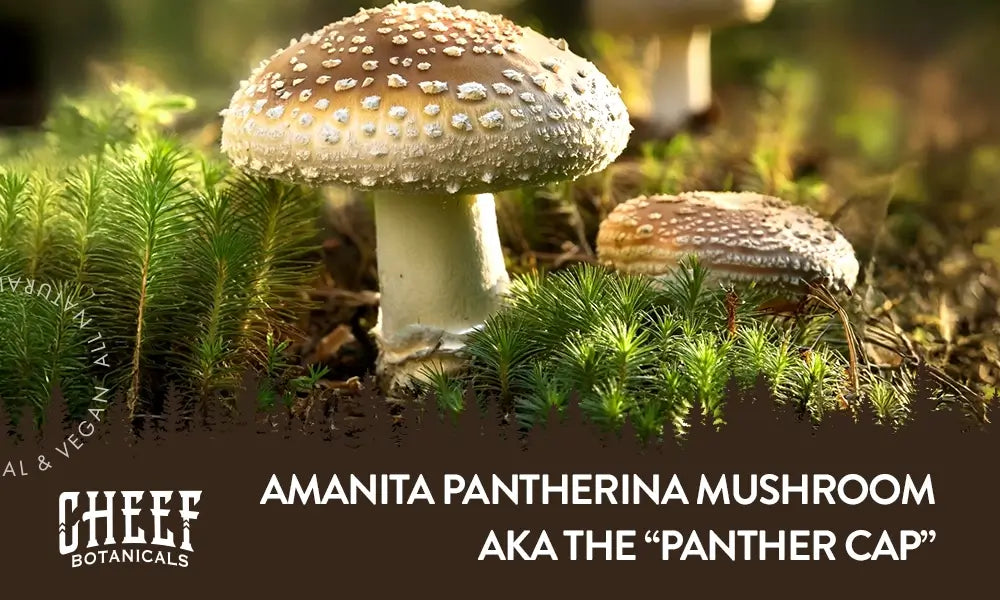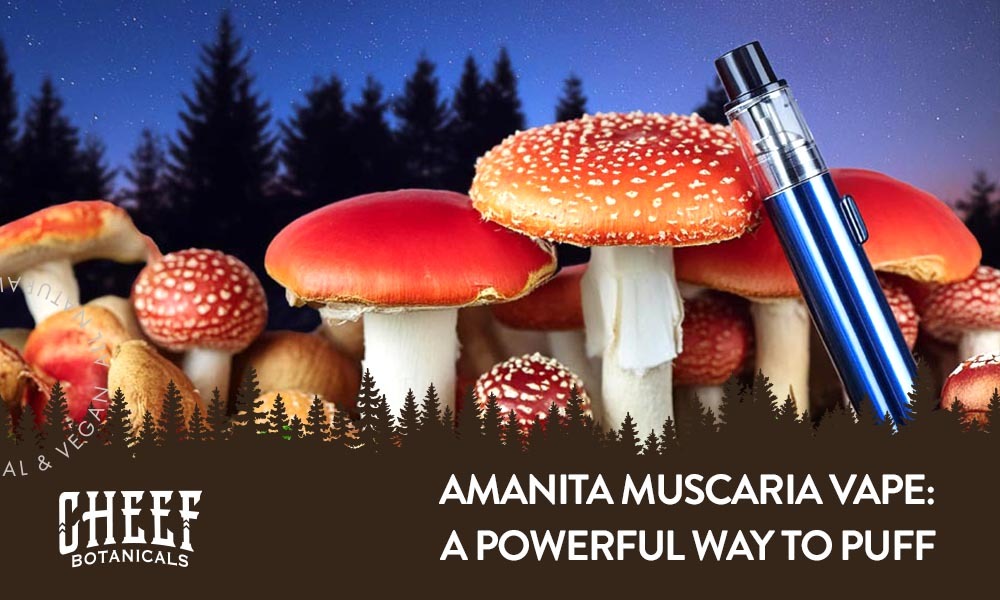Amanita Persicina is a unique mushroom from the Amanita genus that doesn't get the same attention as Amanita Muscaria or Amanita Pantherina. The Amanita genus includes many species, some known for their bright red caps and distinctive features. With Persicina's peach-colored cap and species status, it might be an interesting addition to the cannabis market.
Understanding lesser-known fungi, such as Amanita Persicina, can help you see the mushroom industry in a new light. With its moderately broad cap and floccose edge, this fungi could offer fresh ways to enhance wellness products. However, more research needs to be done to prove its therapeutic worth.
DNA analysis has helped clarify the species status of Amanita Persicina, making it a mushroom that's gaining some attention. Keep reading to see how this fascinating mushroom could bring new possibilities to the evolving holistic health market.
What is Amanita Persicina?
Amanita Persicina is a unique mushroom that mainly grows in the Southeastern United States. You'll often find it in forests, particularly under hard pines and oak trees. This mushroom forms a special connection with these trees through mycorrhizal synthesis, which helps both the trees and the mushroom thrive. Its cap color ranges from a pale pinkish tint to a peach-colored hue, making it easy to spot.
The cap of Amanita Persicina is moderately broad and sometimes has a smooth or very floccose edge. This mushroom prefers the warm, humid conditions typical of the Southeastern United States, which makes it a common sight in those regions. Its presence in these forests adds to the area's natural diversity, playing an important role in the local ecosystem.
Classification and Taxonomy
To understand Amanita Persicina better, it's helpful to know where it fits in the world of Amanita fungi. This mushroom has a unique spot in its classification, showing how it relates to other species. Here's a simple breakdown of its classification:
- Kingdom: Fungi Amanita Persicina belongs to the Fungi kingdom, which includes all mushrooms. This kingdom covers everything from tiny molds to large mushrooms like Amanita Persicina.
- Phylum: Basidiomycota Within the Fungi kingdom, this mushroom is part of the Basidiomycota phylum, known for mushrooms that produce spores on structures called basidia. This feature is common in many mushrooms you might see.
- Class: Agaricomycetes Amanita Persicina belongs to the class Agaricomycetes, which includes many gilled mushrooms. These mushrooms play a major role in nature by breaking down organic material.
- Order: Agaricales In the order Agaricales, you'll find a variety of mushrooms, including many familiar ones like white button and field mushrooms. Amanita Persicina fits into this diverse group, adding to its richness.
- Family: Amanitaceae This mushroom is part of the Amanitaceae family, known for its species with striking cap colors and unique forms. The Amanita genus is well-known within this family.
- Genus: Amanita Amanita Persicina belongs to the Amanita genus, a group famous for its bright caps and distinct features. This genus includes several important North American varieties.
- Species: Amanita persicina Amanita Persicina is the species name, marking it as a unique member of the Amanita genus. This species stands out among other North American varieties.
How to Identify Amanita Persicina

Identifying Amanita Persicina is easier when you know what to look for. The cap is the first thing you'll notice. It usually starts out bright red, and as it ages, the hues can fade to peach or yellow, often covered with white or yellowish warts.
The vivid cap color makes Amanita Persicina stand out in the forest, especially when growing under oak or pine trees. The cap is moderately broad, and the surface can be smooth or have scattered fragments, giving it a distinct look.
The gills of Amanita Persicina are white and do not attach to the stem, which is a key feature to note. The stem itself is also white and has a ring, along with a bulbous base that helps anchor the mushroom in the soil.
Unlike some other North American varieties, Amanita Persicina typically lacks the well-defined concentric rings and zones on the base of the stem. Instead, the universal veil material is often scattered fragments and patches. This combination of features—cap color, white gills, and a ringed stem with a bulbous base—makes Amanita Persicina a mushroom you can easily identify in the wild.
Comparison with Amanita Muscaria
Amanita Persicina and Amanita Muscaria are both part of the Amanita genus, but they have some noticeable differences. Amanita Muscaria, often recognized by its bright pastel red cap with white warts, is one of the most famous mushrooms in the world.
In contrast, Amanita Persicina is often described as a peach-colored fly agaric because of its reddish-orange cap, which may also feature white or pale yellow warts. Still, the color tends to be less vibrant than that of Amanita Muscaria. Both mushrooms share some similarities, such as white gills free from the stem and a white stem with a ring. Despite these differences, both species are fascinating members of the Amanita genus, contributing to the rich diversity of mushrooms in forests.
Is Amanita Persicina Psychoactive?
Amanita Persicina contains ibotenic acid and muscimol, which, if consumed, may cause mind-altering effects. Similarily, these compounds give Amanita Muscaria its well-known euphoric effects. However, Amanita Persicina might have milder effects compared to Amanita Muscaria because it typically has lower concentrations of these compounds.
Even though Amanita Persicina and Amanita Muscaria share these psychoactive substances, the experience with Amanita Persicina is usually less intense. This means that while it can still have some euphoric effects, it might not be as strong. If you're curious about Amanita Persicina, it's important to understand and approach these potential effects carefully.
Related Post: Amanita Muscaria vs Psilocybin
Potential Side Effects
When you try Amanita Persicina, it's good to know the possible side effects, especially if you're new to consuming this mushroom. Being prepared helps you have a safer experience.
Here are the potential temporary side effects:
- Mild hallucinations
- Dizziness
- Altered perceptions
- Nausea
- Muscle Twitching
- Confusion
These effects are usually temporary but can be strong, especially for those unfamiliar with Amanita mushrooms. It's important to be aware of these possibilities and approach this mushroom with care. Additionally, this Amanita species has not had many studies so it might be safer to opt for Amanita Muscaria products.
Regulatory Considerations
Proper handling and clear identification of Amanita Persicina are essential to ensure safety, especially since this mushroom can have psychoactive effects. If you're integrating it into products or possessing some, taking these precautions is important.
There's also limited research on the safe usage and effects of Amanita Persicina. This means you need to be careful when working with it. By staying informed and educating others in the industry, you can help avoid any potential risks. While Amanita Persicina has potential, it's important to understand the regulations and safety measures prior to handling it.
Cultural and Ethnobotanical Significance
Amanita Persicina may not be as famous as Amanita Muscaria, but it's still important, especially in the Southeastern United States. With its unique cap color, this distinct species has likely been part of local traditions for a long time. Although it doesn't appear much in global folklore, its connection to the natural world in these regions shows its significance.
In cultures close to nature, mushrooms like Amanita Persicina are often respected for their effects and roles in the ecosystem. The psychoactive properties of related Amanita species have tied them to spiritual practices and rituals. Its unique features and presence in the Southeastern United States suggest it might have played a role in local traditions, adding to the broader cultural landscape.
Traditional Use
The traditional use of Amanita Persicina is mush more limited compared to Amanita Muscaria. While Amanita Muscaria is known for its role in various cultural rituals, Amanita Persicina has a very quiet history. Found mainly in the Southeastern United States, this mushroom may have been used in specific cultural practices, but there isn't much documentation to support this.
Given its psychoactive properties, similar to Amanita Muscaria's, Amanita Persicina might have been used in small, local contexts, possibly in spiritual or ritual activities. However, its traditional use remains mostly unknown due to limited research and few records.
Even so, the presence of Amanita Persicina in culturally rich areas suggests it may have had some importance, even if it wasn't widely recognized or documented.
Market Potential
Amanita Persicina, with its psychoactive properties, has possible potential in niche markets, especially alongside the growing interest in cannabis products. As more people explore natural remedies, Amanita Persicina could become appealing due to its unique effects. Perhaps it can be offered as a more subtle option in comparison to Amanita muscaria or Amanita pantherina options.
Though it's less well-known than Amanita Muscaria, Pericina's distinct species status and presence in the Southeastern United States offer new opportunities for market exploration.
However, caution is needed when considering the marketing of Amanita Persicina. This mushroom contains ibotenic acid and muscimol, which can be toxic if not handled properly. Clear communication about these risks is important to ensure consumer safety.
While Amanita Persicina has potential in the market, introducing it carefully with a focus on education and responsible use is key. This way, you can highlight Amanita Persicina's potential while prioritizing safety.
Available Amanita Products Made By Cheef Botanicals

We offer a variety of premium, lab-tested Amanita products. From dried mushrooms to Amanita plus THC and THCp gummies, we have you covered for all your mushroom needs. Here is a quick breakdown of our therapeutic fungi options.
- Dried Mushrooms (Amanita Muscaria). Freshly dried Amanita mushrooms. Can be eaten raw or added to smoothies or food recipes.
- Amanita Muscaria Gummy Cubes. Contains Amanita muscaria extract and natural gummy ingredients, colorings, and flavorings. Provides pure and long-lasting effects
- Amanita Muscaria + THC Gummies. Want some THC with your Amanita? Try our THC + Muscaria gummies for an enhanced mushroom. experience.
- THC + THCp + Amanita Muscaria Gummy Cubes. Like potent effects? Try our THC + THCp + Amanita gummy cubes. Contains two of the most potent cannabis compounds plus Amanita muscaria extract.
Final Thoughts on Amanita Persicina
Amanita Persicina offers exciting potential for the cannabis industry, especially in niche markets focused on psychoactive products. With its unique properties, this distinct species could add to the growing range of natural remedies and cannabis-related offerings. However, it's important to approach Amanita Persicina carefully, given the potential risks from compounds like ibotenic acid and muscimol.
Ensuring that people understand the effects and proper use of Amanita Persicina helps unlock its potential while keeping safety in mind. There are also opportunities for future research and product development, particularly in terms of how Amanita Persicina might fit into the broader cannabis market. As interest in natural and psychoactive products grows, Amanita Persicina could become an important player in this evolving industry.
Top-Rated Products Featuring Amanita Mushrooms


 Amanita Muscaria Gummies - Top Seller
Amanita Muscaria Gummies - Top Seller
 Amanita Muscaria Dried Mushroom Caps - Excellent Choice
Amanita Muscaria Dried Mushroom Caps - Excellent Choice
 Amanita muscaria + Delta-9 THC + THCp Gummy Cubes - Highly Rated
Amanita muscaria + Delta-9 THC + THCp Gummy Cubes - Highly Rated
 Amanita Muscaria + D9 Gummies - Good Value
Amanita Muscaria + D9 Gummies - Good Value



Leave a comment
This site is protected by hCaptcha and the hCaptcha Privacy Policy and Terms of Service apply.